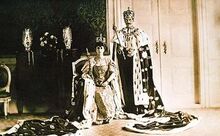- One or more subjects within this article are under rework, and may no longer be accurate.
Haakon VII (Prince Carl of Denmark, born Christian Frederik Carl Georg Valdemar Axel), was the first king of Norway after the 1905 dissolution of the personal union with Sweden. As one of the few elected monarchs, Haakon quickly won the respect and affection of his people.
History[]
Early years as a Danish prince[]
Known in his youth as Prince Carl of Denmark (namesake of his maternal grandfather the King of Norway etc), he was the second son of the future King Frederick VIII of Denmark and a younger brother of the future King Christian X of Denmark. He personally became king of Norway before his father and brother became kings of Denmark. He was a paternal grandson of King Christian IX of Denmark (during whose reign he was prince of Denmark) and a maternal grandson of King Charles XV of Sweden, who was also king of Norway (as Charles IV).
Prince Carl was born in Charlottenlund Palace. He belonged to the Schleswig-Holstein-Sonderburg-Glücksburg (shortened to House of Glücksburg) branch of the House of Oldenburg. The House of Oldenburg had been the Danish royal family since 1448, and between 1536-1814, also ruled Norway when it was part of the Kingdom of Denmark-Norway. The house was originally from northern Germany, where also the Glucksburg (Lyksborg) branch held their small fief. The family had permanent links with Norway already beginning from late Middle Ages, and also several of his paternal ancestors had been kings of independent Norway (Haakon V of Norway, Christian I of Norway, Frederick I, Christian III, Frederick II, Christian IV, as well as Frederick III of Norway who integrated Norway into the Oldenburg state with Denmark, Slesvig and Holstein, after which it was not independent until 1814). Christian Frederick, who was King of Norway briefly in 1814, the first king of the Norwegian 1814 constitution and struggle for independence, was his great-granduncle.
In 1896, Prince Carl married his first cousin Princess Maud of Wales, youngest daughter of the future King Edward VII of the United Kingdom and his wife, Princess Alexandra of Denmark, daughter of King Christian IX of Denmark and Princess Louise of Hesse-Cassel. Their son, Prince Alexander, the future Crown Prince Olav, was born on 2 July 1903.
Accession to the Norwegian throne[]

The coronation of Haakon VII and Queen Maud on 22 June 1906
After the Union between Sweden and Norway was dissolved in 1905, a committee of the Norwegian government identified several members of European royalty as candidates for Norway's first king of its own in several centuries. Gradually, Prince Carl became the leading candidate. He had a son (and hence an heir to the throne) and Princess Maud's ties to the British royal family were viewed as advantageous to the newly-independent Norwegian nation.
The democratically-minded Carl, aware that Norway was still debating whether to retain its monarchy or to switch to a republican system of government, was flattered by the Norwegian government's overtures, but declined to accept the offer without a referendum to show whether monarchy was truly the choice of the Norwegian people.
After the referendum overwhelmingly confirmed by 79 percent majority that Norwegians desired to retain a monarchy, Prince Carl was formally offered the throne of Norway by the Storting (parliament) on 18 November 1905. When Carl accepted the offer that same evening (after the approval of his grandfather Christian IX of Denmark), Carl became Haakon VII. In so doing, he succeeded his grand-uncle, Oscar II of Sweden, who had abdicated the Norwegian throne in October following the agreement between Sweden and Norway on the terms of the separation of the union. Haakon's coronation took place in Nidaros Cathedral in Trondheim on 22 June 1906.
